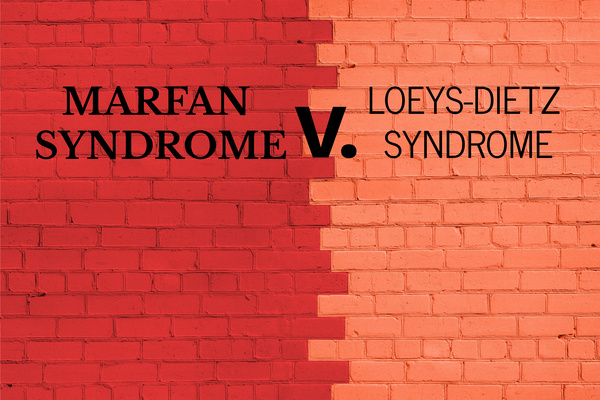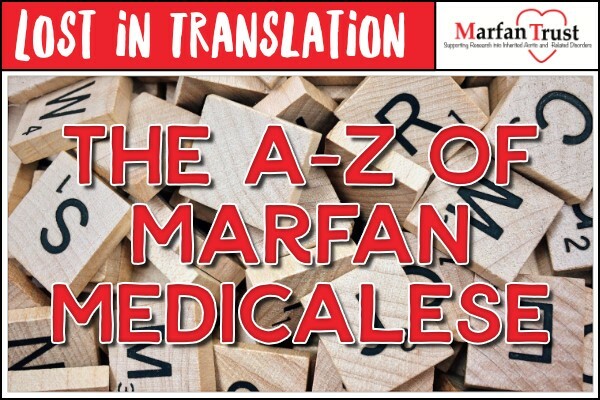A family affair that often percolates down the generations, Marfan syndrome itself belongs to a wider family of connective tissue disorders. As our Trust expands to support people with a parallel condition, Loeys-Dietz syndrome, we thought to create a compare-and-contrast of these connective 'cousins'. After all, several have been diagnosed with one only to find they have the other!
[The table below is a comprehensive compare-and-contrast of the two syndromes, with the differentiators highlighted in bold. And further down we include a Case history of a supporter diagnosed with MFS, then undiagnosed, and potentially rediagnosed with LDS].
| MARFAN SYNDROME | LOEYS-DIETZ SYNDROME | |
| CAUSE | Mutation of fibrillin-1 gene (FBN1) on chromosome 15 | Mutations in several different genes, including: TGFBR1, TGFBR2, SMAD3, TGFB2, TGFB3 |
| INCIDENCE | 1 in 3,000 population | Less than 1 in 100,000 population |
| SKELETAL SIGNS | Tall stature (increased armspan greater than height); | Typically normal stature; |
| High-arched palate in the mouth and crowding of teeth; | Premature fusion of the skull bone (craniosynostosis); | |
| Long skull; | Long skull; | |
| Flat cheekbones; | ||
| Micrognathia (small chin) and/or retrognathia (receding chin); | ||
| Arachnodactyly (long, thin, spidery fingers); | Long, thin fingers | |
| Joint hypermobility (loose joints); | Contractures of joints which restrict joint movement; | |
| Scoliosis (spinal curvature); | Scoliosis (spinal curvature); | |
| Pectus deformity (indented or protruding chest); | Pectus deformity (indented or protruding chest); | |
| Lax ankles & flat feet. | An inward- and upward-turning foot (club foot); | |
| Malformation or instability of the spinal bones in the neck; | ||
| Osteoarthritis. | ||
| ENT | Deviated septum; | Cleft Palate; |
| Narrow sinuses; | Bifid (split or broad) uvula (the uvula is the small piece of flesh that hangs down from the back of the mouth). | |
| Beaked nose; | ||
| Low-set ears; | ||
| Narrow, angled ear canals. | ||
| CARDIOVASCULAR COMPLICATIONS | Aortic aneurysm (dilation); | Aortic aneurysm (dilation); |
| Aortic dissection (tear) or rupture; | Aortic dissection (at an early age); | |
| Mitral valve prolapse; | Mitral valve prolapse; | |
| Aortic valve leakage; | Aortic valve leakage; | |
| Arterial tortuosity – twisting or spiralled arteries demonstrated by arterial dye studies; | ||
| Congenital heart defects; | Congenital heart defects (including patent ductus arteriosus (PDA), atrial or ventricular septal defect (ASD/VSD) and bicuspid aortic valve (BAV). | |
| EYES | Slight downward slant to the eyes; | Slight downward slant to the eyes; |
| Blue sclerae (blue tinge to the whites of the eyes); | ||
| Deep-set eyes; | Wide-set eyes; | |
| Myopia; | Myopia; | |
| Lens dislocation; | ||
| Retinal detachment; | Retinal detachment; | |
| Strabismus (squint). | Strabismus (squint). | |
| LUNGS | Pneumothorax | |
| SKIN | Stretchy skin over neck, elbow; | Translucent skin; |
| Striae (stretch marks) in lumbar area (lower back), shoulders, chest, knees. | Soft, velvety skin; | |
| Easy bruising; | ||
| Abnormal scarring. | ||
| NEUROLOGICAL | Dural Ectasia (pain in pelvis and legs, coming from the back). | |
| GASTROINTESTINAL | Irritable bowel syndrome; | Gastrointestinal inflammatory disease. |
| Gastroparesis (slow gastric emptying); | ||
| Intestinal dysmotility. | ||
| OTHER FEATURES | Hernias; | Hernias; |
| Varicose veins. | Food or other allergies; | |
| Hollow organs such as intestine, uterus and spleen prone to rupture. | ||
CASE HISTORY
Of interest, a supporter recently approached us to say:
“I’ve lived for the last thirty or so years thinking I had Marfan syndrome. During my last genetics appointment I was told that I don’t in fact have Marfan syndrome, but may have Loeys-Dietz syndrome (LDS). What difference does this new diagnosis make If any?”.
We replied, saying: “It is a label. Marfan syndrome was described well before Loeys-Dietz syndrome and people were sometimes misdiagnosed with Marfan, then subsequently found to have LDS once it became known. However, in the meantime, you have been monitored and your symptoms have been controlled with appropriate treatment, so it makes little practical difference as to whether these symptoms are a result of MFS or LDS. Knowing the correct diagnosis depends on finding the gene change. LDS can present earlier than MFS and your doctors do need to know the cause in order to choose the best treatment. Also, your children can be screened as there is a 50:50 chance they have inherited LDS.” It is helpful for your doctors to know which condition you have as there may be slight differences in ongoing management and the opportunity for accurate testing for your children and other family members.









